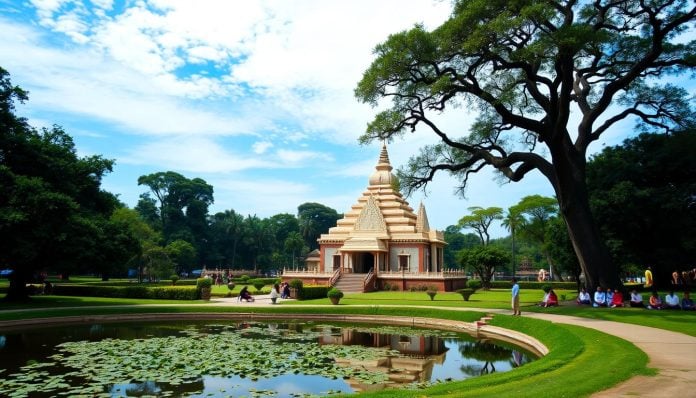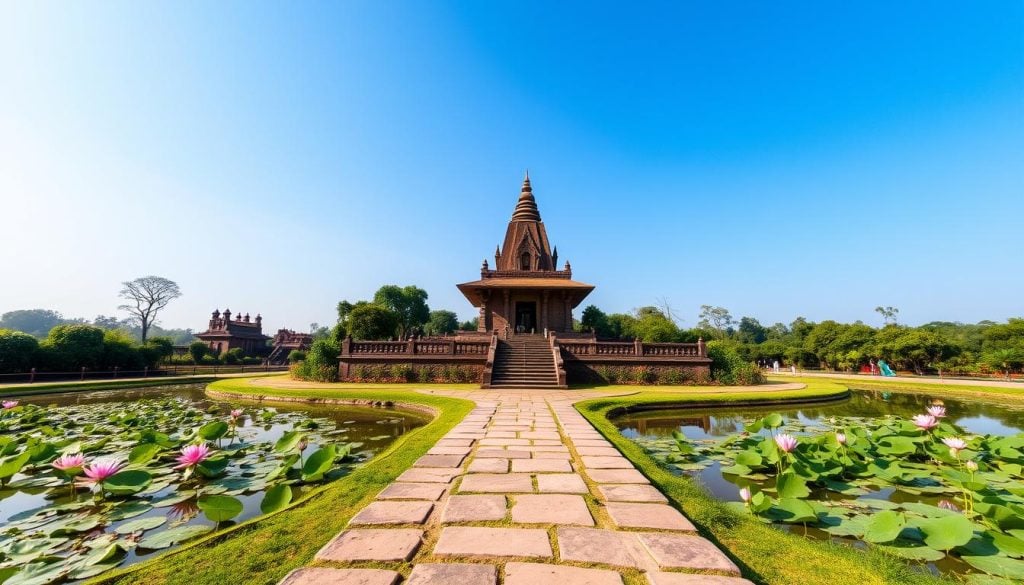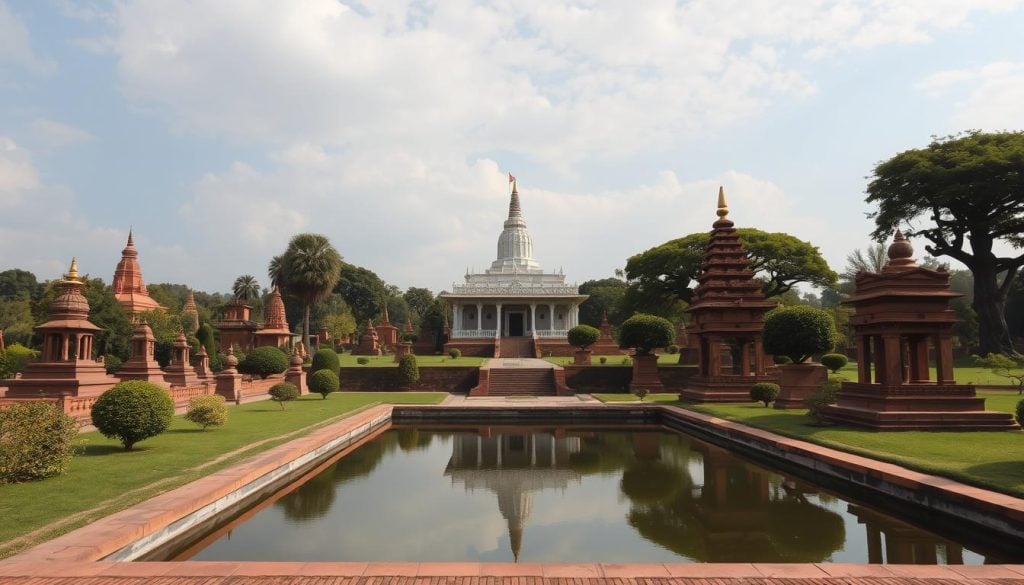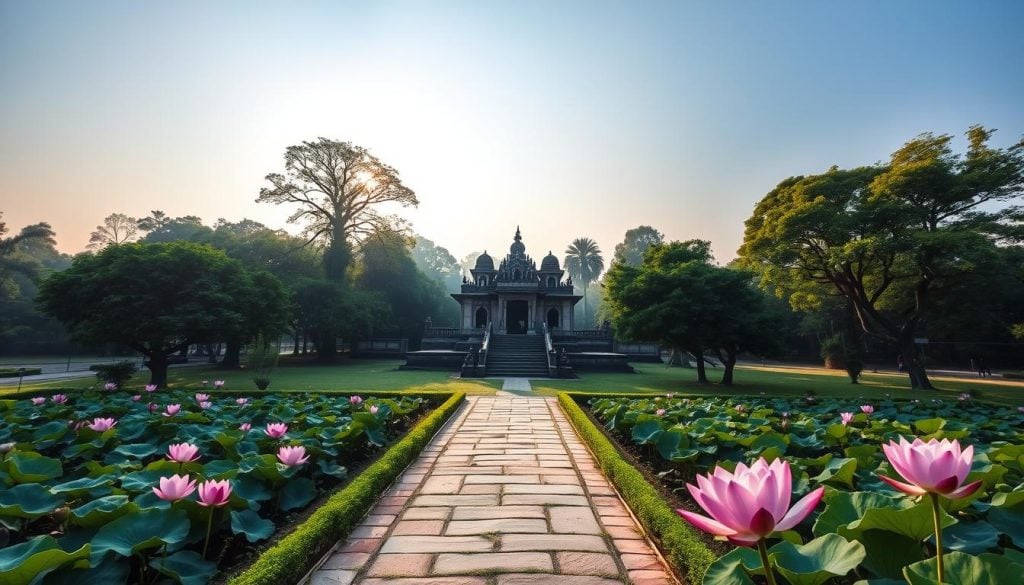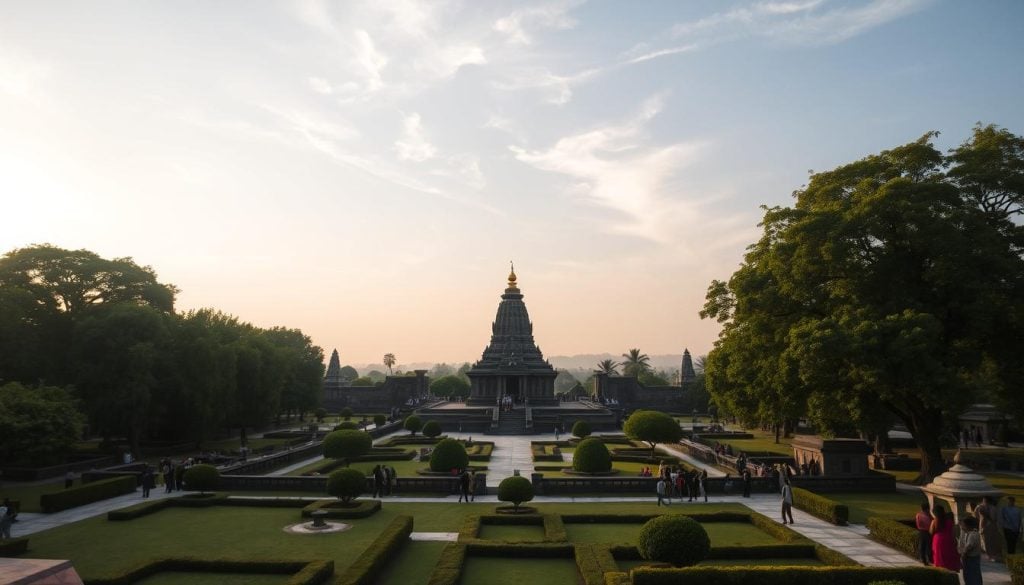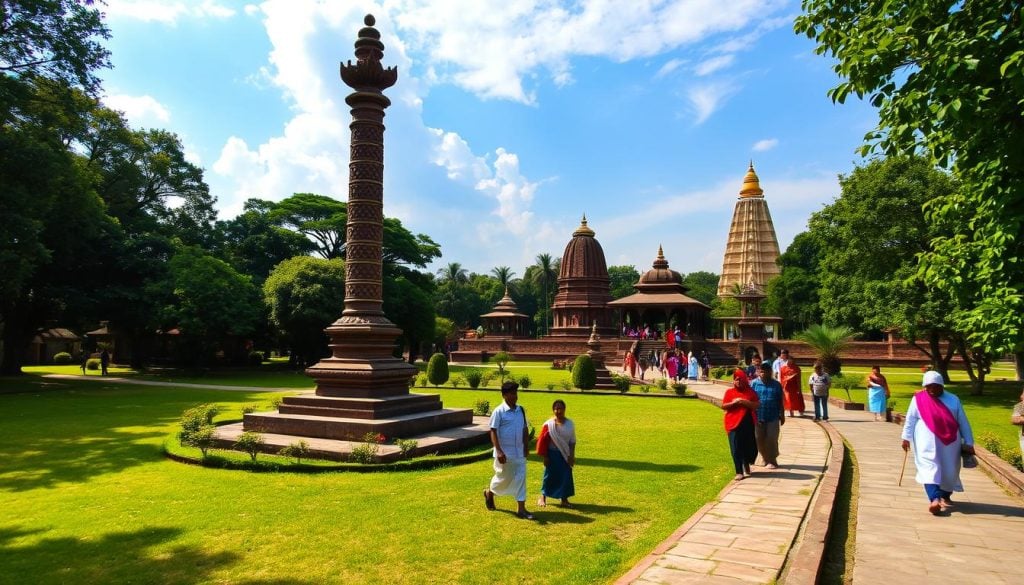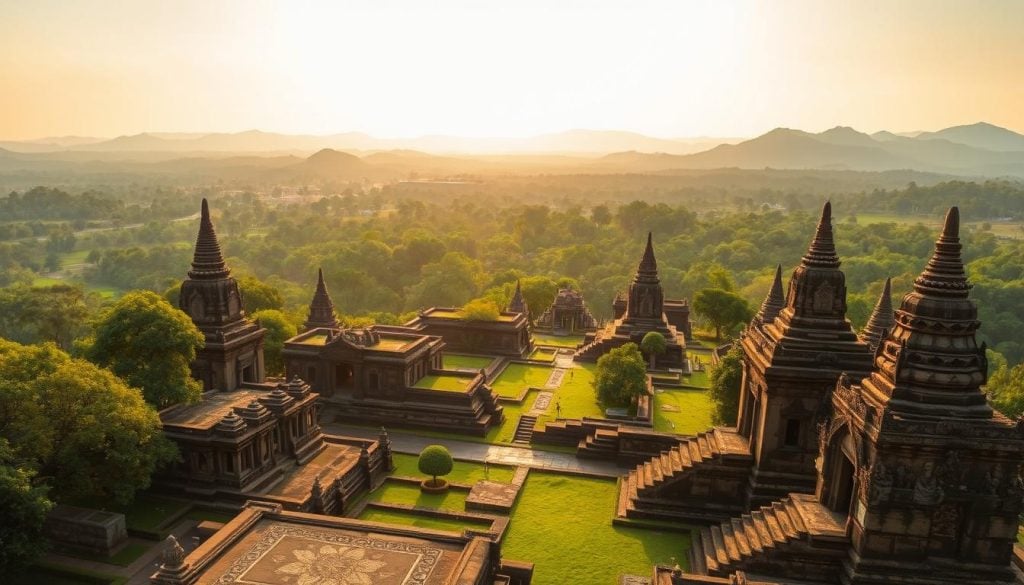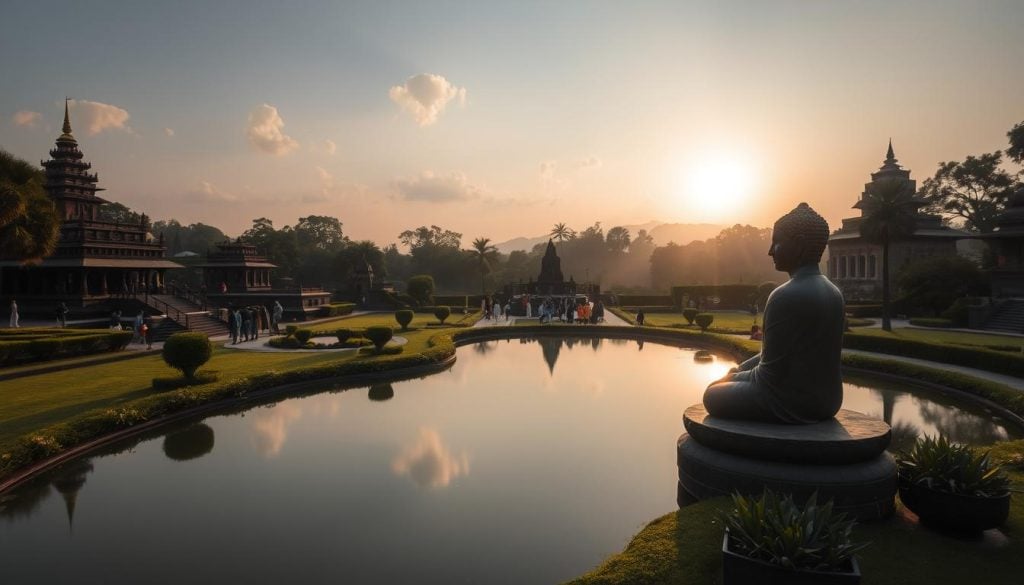Ever thought about visiting the birthplace of Buddha? How might it change your view of Buddhism? Lumbini, a UNESCO World Heritage Site, is where Siddhartha Gautama, the future Buddha, was born. This journey will reveal the deep historical and spiritual value of this site.
Visiting Lumbini is more than just seeing sights. It’s a dive into the heart of Buddhism, where old stories and teachings come alive. The stories here offer deep insights into a spiritual journey. Let’s explore why Lumbini is more than a place to see—it’s a journey through time.
Introduction to Lumbini
Lumbini is a key lumbini pilgrimage site known for its deep religious and cultural value. Located in Nepal, it offers a calm space for thought and spiritual growth. It’s the birthplace of Buddha, drawing many pilgrims and tourists yearly to learn more about Buddhism.
The history of Lumbini is filled with ancient traditions, crucial to the Buddhist story. Visitors can see many historical sites, like peaceful gardens and old monasteries. Each one shares a piece of the Buddha’s life and teachings, fostering reflection and a closer bond with Buddhism.
Walking through this sacred place, you feel a lively atmosphere that helps you find yourself and honor your faith. Lumbini’s importance goes beyond its history; it’s a symbol of faith that brings people together. It invites everyone to experience its peace and spiritual depth.
| Feature | Description |
|---|---|
| Lumbini Pilgrimage Site | A place of deep spiritual significance, marking the birthplace of Buddha. |
| Historical Significance | Rich in stories and cultural heritage, pivotal in the history of Lumbini. |
| Sacred Atmosphere | A tranquil environment conducive for meditation and spiritual growth. |
| Ancient Structures | Home to ancient monasteries and landmarks reflecting the teachings of Buddha. |
History of Lumbini
The history of Lumbini is deeply connected to Buddhism’s origins. It is the birthplace of Siddhartha Gautama, known as the Buddha. Over 2,500 years ago, his birth happened here, confirmed by Chinese pilgrims and archaeology.
For centuries, Lumbini was forgotten, buried by time and nature. In the 19th century, explorers found its Buddhist heritage again. Excavations uncovered structures and relics, shedding light on its past.
Now, Lumbini is a key site in Buddhism. People from all over come to connect with the Buddha’s legacy. Walking here, they join a journey of devotion that spans millennia.
The Significance of Lumbini as the Birthplace of Buddha
Lumbini is more than just a place on a map. It’s where Buddha was born, making it a key spot for those seeking spiritual growth. It connects us to Siddhartha Gautama’s journey, which became the path of Buddhism.
When you visit Lumbini, you feel a calm that touches everyone. It’s not just for those who follow Buddhism. The simple stone marking Buddha’s birth reminds us of his teachings. These teachings have brought peace to many around the world.
Walking through Lumbini’s gardens, you can feel the deep respect for this site. It’s a place where Buddha’s life and teachings live on. It inspires and guides people on their own paths.
Learning about Buddha in Lumbini
Lumbini is where Buddha’s teachings began. It’s a place filled with history and importance. Understanding Buddha’s early life helps us grasp his teachings, shaped by his experiences here.
Understanding Buddha’s Early Life
Buddha, or Siddhartha Gautama, was born in Lumbini. His early life was marked by sheltered beginnings but also harsh realities. These experiences drove his search for truth, leading to deep insights about life and suffering.
Visiting Lumbini lets you see how his teachings started. It shows his journey from prince to enlightened being.
The Impact of Lumbini on Buddhist Teachings
Lumbini is key for those interested in Buddhism. It attracts pilgrims from around the world. The village’s calm and history make it perfect for learning and reflection.
Here, you can see how Buddhism has grown and changed. It deepens your connection to Buddhism’s core messages.
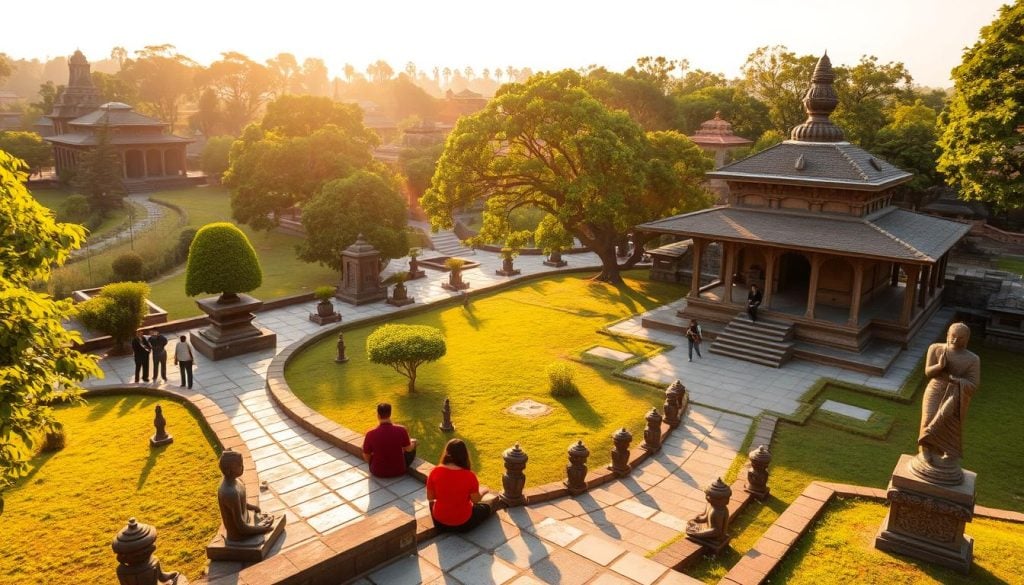
Visiting Lumbini: What to Expect
Visiting Lumbini is more than just seeing sights. It’s a journey into the heart of spirituality and culture. The Lumbini complex, a UNESCO World Heritage Site, is a place of deep meaning. Here, you’ll find sacred sites that tell the story of Buddhism.
Overview of the Lumbini Complex
The Lumbini complex is a masterpiece that honors Buddha’s birthplace. It has beautiful gardens, paths, and spots for meditation. These invite you to find peace and think deeply.
- An extensive collection of national monasteries, each representing different countries and their unique architectural styles.
- Natural landscapes that enhance the spiritual atmosphere of sacred sites in Lumbini.
- Meditation centers aimed at deepening your understanding of Buddhist practices.
Monasteries and Cultural Diversity
Lumbini is known for its cultural richness. Each monastery shows the unique way Buddhism is practiced around the world. You’ll see:
- Thai Monastery: Known for its elegant design and peaceful retreat spaces.
- Chinese Monastery: A space showcasing intricate artistry and traditional Chinese architecture.
- German Monastery: Emphasizes minimalistic design, blending modern elements with traditional spaces.
Whether you’re meditating or on a guided tour, Lumbini offers a special experience. It shows the worldwide respect for Buddha’s teachings.
Key Sacred Sites in Lumbini
Lumbini is filled with sacred sites that are very important in Buddhist culture. The Mayadevi Temple, Ashoka Pillar, and the Sacred Pond are key places to visit. They give us a look into Buddha’s life and his early days.
The Mayadevi Temple
The Mayadevi Temple is a major pilgrimage site in Lumbini. It’s where Queen Maya Devi gave birth to Siddhartha Gautama, who became Buddha. Inside, you can see the old birthing structure in a peaceful setting. Many visitors feel calm and spiritual here.
The Ashoka Pillar
The Ashoka Pillar was built by Emperor Ashoka in the 3rd century BCE. It’s a sign of Buddhist faith and history. The pillar marks the Mayadevi Temple and has inscriptions about Buddha’s life. Its beauty inspires visitors to think deeply about Buddhism’s history.
The Sacred Pond
The Sacred Pond is a key site in Lumbini. Queen Maya Devi bathed here after Buddha’s birth. It’s a place of purification and respect. The pond’s calm setting is perfect for meditation and reflection.
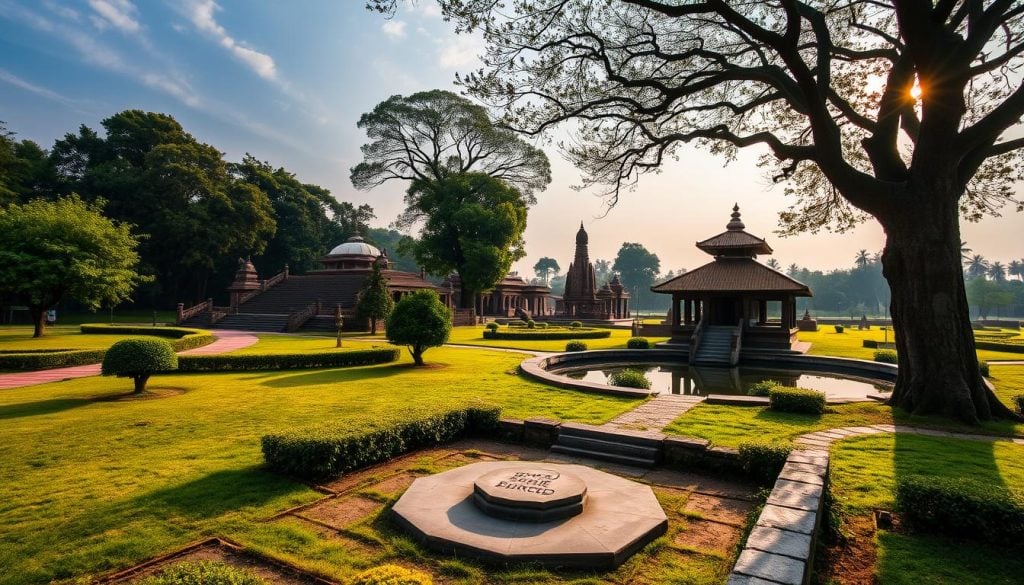
| Site Name | Significance | Year Established |
|---|---|---|
| Mayadevi Temple | Birthplace of Buddha | 6th century BCE |
| Ashoka Pillar | Marking Buddha’s Birth | 3rd century BCE |
| Sacred Pond | Place of Queen Maya Devi’s Bath | 6th century BCE |
Planning Your Lumbini Pilgrimage
Planning a trip to Lumbini is important. Think about when to go, how to get there, and where to stay. This will make your visit better.
Best Time to Visit Lumbini
The best time to visit is from November to March. The weather is cool, making it easier to explore. You can enjoy the sites without getting too hot or cold.
How to Get There
There are several ways to reach Lumbini. You can drive from Pokhara in five hours or fly from Kathmandu. Once you arrive, a short drive will take you to the site. You’ll see beautiful views along the way.
Accommodation and Reservations
There are not many places to stay near Lumbini. So, book early to find a place. Good planning helps you have a comfortable stay while exploring.
Exploring Nearby Archaeological Sites
Looking into Buddha’s early life takes you to several sites near Lumbini. These places give a deeper look into his formative years. The Ancient City of Kapilavastu, where Buddha spent his childhood, is a key site. You might also want to see Kudan and Devadaha, each offering unique views into Buddha’s journey and the historical context of his teachings.
The Ancient City of Kapilavastu
The Ancient City of Kapilavastu is crucial for those interested in Buddhism’s origins. It was a thriving city where Buddha was raised as royalty. Archaeological discoveries show homes, defenses, and relics that reveal early human life. Visiting here lets you see the environment that shaped Buddha’s teachings.
Other Significant Sites: Kudan and Devadaha
Kudan and Devadaha are also important and show different parts of Buddha’s story. Kudan is famous for its stupa, where Buddha first taught after enlightenment. Devadaha is where Buddha’s mother was born, giving insight into his family. Exploring these sites near Lumbini deepens your understanding of his life and spiritual growth.
| Site Name | Significance | Key Features |
|---|---|---|
| Ancient City of Kapilavastu | Childhood home of Siddhartha Gautama | Residential structures, fortifications, relics |
| Kudan | Location of Buddha’s first teachings | Historic stupa, archaeological remains |
| Devadaha | Birthplace of Siddhartha’s mother | Ruins, cultural artifacts |
Visiting these sites near Lumbini adds to your knowledge of the historical landscape that shaped Buddha’s teachings and the era’s culture.
A Spiritual Pilgrimage Experience
Going on a spiritual journey to Lumbini is a special chance for self-reflection and connecting with Buddhism’s roots. This sacred place offers a calm setting for meditation, helping you grow personally.
Meditation and Reflection in Sacred Spaces
In Lumbini, you’ll find spots made just for meditation and thinking. The quiet surroundings help you focus deeply, letting you dive into Buddha’s teachings and understand yourself better. The natural beauty and history of the place make your experience even more meaningful, leading to moments of deep insight.
The Atmosphere of Peace and Serenity
Lumbini is known for its calm, making it perfect for a spiritual trip. People often feel a deep sense of peace when they arrive. Walking through this peaceful place, you’re encouraged to fully immerse in meditation, reflecting on your life and the teachings of Buddhism.
Lumbini’s Historical Significance
Lumbini is more than just where the Buddha was born. It holds deep spiritual value. It’s a place where many come to seek enlightenment. Learning about Lumbini helps us understand Buddhism better.
Connection to Buddha’s Life and Teachings
Lumbini is linked to the Buddha’s life. It’s where Siddhartha Gautama, the Buddha, was born. This place marks the beginning of his path to enlightenment.
Important moments in his life, like his search for answers, happened here. Lumbini reminds us of the Buddha’s teachings. These teachings have touched many lives throughout history.
Influence on Global Buddhism
Lumbini’s impact on Buddhism goes beyond its location. People from all over come to learn and share. This exchange enriches our understanding of Buddhism.
The blend of tradition and modernity in Lumbini inspires new views on Buddhism. It shows how Lumbini shapes our perception of this ancient philosophy.
Getting Around in Lumbini
Exploring Lumbini is a joy that lets you see its rich history and calm surroundings. You can easily get around by walking and biking. This way, you can enjoy your visit at your own pace.
Walking and Bicycling Tours
Try a walking or biking tour for a special experience. Walking lets you see many historical sites, temples, and monasteries. Biking is fun and easy, without the need for a car.
While biking, you can see local culture and talk to friendly people.
Local Tips for a Comfortable Experience
To make your visit better, follow these tips:
- Wear comfy shoes for walking, as you’ll see many places.
- Don’t forget sun protection like sunscreen and hats, especially in the afternoon.
- Dress modestly to respect local customs, as Lumbini is a sacred place.
- Drink lots of water to stay hydrated, especially when it’s hot.
- Plan your route to see all the important landmarks.
Remember these tips to improve your visit to Lumbini. They will help you enjoy your time exploring and make your trip memorable.
Conclusion
Traveling to Lumbini to learn about Buddha’s origins is a journey that enriches your understanding of Buddhism. It also deepens your personal reflections on its teachings. The sacred landscape, full of historical significance, offers a deep connection to Buddha’s life and philosophy.
Exploring Lumbini’s key sites, like the Mayadevi Temple and the historic Ashoka Pillar, is more than just visiting. They are crucial for learning about Buddha in Lumbini. Each site blends with the deep spiritual heritage of this remarkable birthplace, offering a chance for introspection and growth.
Your journey in Lumbini is one of peace and inspiration. It helps you reflect on Buddha’s lessons and how they apply today. Every step on this sacred soil brings you closer to the heart of Buddhist teachings, making your visit unforgettable.

































